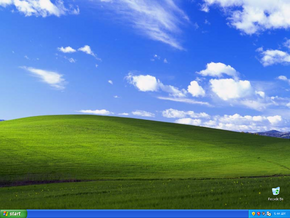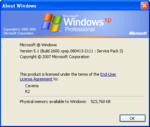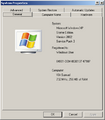Windows XP build 2600.5512
| Build of Windows XP | |
 | |
| OS family | Windows NT |
|---|---|
| Version number | 5.1 |
| Build number | 2600 |
| Build revision | 5512 |
| Architecture | x86 |
| Build lab | xpsp |
| Compiled on | 2008-04-13 |
| SKUs | |
| Home Edition (K, N, KN) Professional (K, N, KN) Tablet PC Edition Media Center Edition Starter Edition | |
| About dialog | |
Windows XP build 2600.5512 is the official RTM build of Windows XP Service Pack 3. It was released to manufacturing on 21 April 2008 and was made available for download via Windows Update and the Microsoft Download Center on 6 May 2008. It was also automatically distributed to consumers running Windows XP through Automatic Updates on 10 July 2008.
This release would be used as the base for Windows Embedded Standard 2009 and POSReady 2009. It was also pushed out to Windows XP Starter Edition, Windows XP Tablet PC Edition 2005, Windows XP Media Center Edition 2005, Windows Fundamentals for Legacy PCs, and Windows Embedded for POS.
Separately, the 12 July 2011 "Update Rollup" for Windows XP SP3 installs Internet Explorer 8, Windows Media Player 11, DirectX 9.29, Windows Automation API version 3.0, Microsoft NetMeeting 3.02, Windows Live Essentials 2009, Windows PowerShell and Windows Remote Management 2.0, Kernel-Mode Driver Framework and User-Mode Driver Framework version 1.9, the Remote Desktop Protocol 7.0, the Windows Sidebar and the Windows Defender Antivirus, Windows Search 4.0, .NET Framework versions 3.5 SP1 and 4.0, the Visual C++ 2010 runtime and Windows Installer 4.5—the latest versions of these components supported on this build.
NFO file[edit | edit source]
NFO contents
░░░░░░░░░░░░░░░░░░░░░░░░░░░ ░░░░░░░░░░░░░░░░░░███████░░░█████░░░░░░░░░░░░░░░░░
░░█████████ ░░░░░░░░░░ ░█████░░░░░░░█████░░░░░░██ █░░█▀ █░░░░░░░██████░░░░
░▒█ ▀███████████ ██▀ █░░░░░████████░░░░██ ███ █░█▀ ██ █░░░░░██▀ █░ ░░
░▒█ █████ ██▀ ██ ▀█░███▀ █░░░░█ ██░█ ██▀ ███ █░░░██▀ ███ ▀█░ ░
░▒█ █░░░███████████ █ █████ ▀██ █████ █░░░░█ ██░░█ █ ██░█ █░░█▀ ███░██ ██░
░▒█ █░░░░░░░░░░░░██ ▀ ██░░░██ ███░░█ █░░░░█ █░░░█ █ ██░░█ █░█▀ ███░░░░█ █░
░▒█ █░░░░░░███████ ██░░░░░██████░░░░█ ▀▀▀▀▀▀▀ █░░░█ █ █░░░█ ██▀ █████░░░██ █▒▒
░▒█ █░░░████ ▄▄▄▄▄▄ ██░░░░░░░░░░░░░░░░███████████░░░█ █ █░░░█ ██ ████ ██░░░█ ██▒
░▒█ █░░░█ ▄▄█▒▒▒▒█▄ ████░░░░░░▒▒░░░░░░░░░░████ █▒▒░█ █ █░▒░█ █ █░█ █░▒░█ █▒
▒▒█ █░░░█ █▓▓▒▒▒▒▒█▄▄▄ ██████░░▒░░░░░░█████ █░▒▒█ █ █▒▒▒█ █ ████ █ ██▒░██ █▒
▒▒█ ██░░██ ▀▀▀▀▀▀█▒▒▒▒█▄▄ ███▒▒▒▒░███ ██ █▒▒░█ █ █░▒▒█ ▀ █░█ █ █▒▒░█ █▒
▒▒█ █▒▒░█ ▀▀▀█▒▒▒█▄▄▄▄ █░▒▒▒██ █████ █▒▒░█ █ █▒▒░█ ██░█ ███ █▒▒▒█ █▒
▒▒█ ██░▒▒██ ████ ▀▀█▒▒▒▒▒█ ██▒▒▒░█ ███░░▒█ ██▒▒██ █ █▒▒░█ █▒▒█ █ █ █▒▒▒█ █▒
▓▒█ █▒▒▒▒▒████░██████ ████▒▒█ █▒▒▒▒░█ █▒▒▒▒▒▒█ █▒▒░█ █ █░▒▒████▒█ █▒█ █▒▒▒█ █▒
▓▓█ ██▒▒▒▒█████████ █▓▓█ █▒▒▒▒░█ ▀█▒▒▒███ █▒▒░█ ██ █░▒▒▒░██░█ ██▒█ █▒▒░█ █▓
▓█▄ ██▒▓▒█ ▄▄▄▄▄▄ █ █▒▓█ █▒▒▒▒░██ █▒▒▒█ █░▓░█ █░▒▓▓██░░█ █▓█ █░▓▓█ █▓
▓▓█▄ █░▓▒█ ██ █████ █▒▓█ ██░▒▒▒▒█ █▒▓▒█ ███▓▓░██████▓▓▓░██░░██ █▓█ █░▓░█ █▓
▓▓▓█ █▓▓░██ ▀ ███████ ▄█▓▓█ █▓▓▓▒▒█ ▀█▓▓█ ██░▓░▓▓▓▓▓▓▓▓▓░░██▓▓░█ █▓█ █▓▓██ █▓
▓▓█ █▓▓▓░█ ███░███ ▄█▓▓▓██ █░▓▓▓░██ █▒▓█ █▓▓█████████▓▓▓░█▓▓░█ ██ █▓▓█ ▄█▓
▓▓█ ██▓▓▒████░███ ▄██▓▓▓▓▓█ ██▓▓▓▓░█ ▀█▓█ █▓▓█ ██▓▓▓██▓▓▓█ ▀ █▓▓█ █▓▓
▓█▄ █▓▓▒▓▓░░██ ▄██▓▓▓▓▓▓▓█ █░▓▓▓▓██ ███ ██▓░█ █████▄ █▓░▓██▓▓▓██ ██▓██ █▓▓
▓▓█ █▓▓▓▓▓▓██ ▄██▓▓▓ ▓ ▓██ █░▓▓▓▓░█ ██ █▓███ █▓▓▓██ █▓▓▓░███▓▓██ █▓██ ▄█▓▓
▓▓█ █▓▓▓▓███ ▄█▓▓▓ ▒ ▓▓█ ██░▓▓░██ ██ ████ █▓▓▓▓█ █░░███ ██▓▓█████ ▄█▓▓▓
▓▓█ ██▓▓██ ▄█▓▓ ░ ▓█▄ ██████ ▄██ ███▓▓▓▓█ ████ ███░░██ ▄█▓▓ ▓
▓▓█▄ ████ ▄██▓▓ ▓▓█▄ ██ ▄█▓████████▓▓▓▓▓▓█▄ ██ ▄██▄ ████ ▄█▓▓ ▓
▓▓▓█ █▓▓▓ ▓▓█ ▄███▓▓▓▓▓▓▓▓▓▓▓ ▓▓▓█▄ ▄█▓▓██▄ █▓▓ ▒
▓▓████████▓ ▓▓█████▓▓▓▓▓ ▓ ████▓▓▓▓▓███████▓ ░
▓▓▓▓▓▓▓▓▓▓▓ ▓▓▓▓▓▓▓▓ ▒ ▓ ▓
▓ ▓▓ ▓ ░ ▒ ▒
▓ ▓ ▒ ░ ░
▒ ▓ ░
░ ▒
TEAM ETH0 PRESENTS
Microsoft.Windows.XP.Home.Retail.SP3.Integrated-ETH0
▀▄▄ ▄▄▀
▄▓▓▓▓▄▄▄ ▄▄▄▓▓▓▓▄
▄ ▀▀▀█▓▓▓▓▓▓▓▄ RELEASE INFO ▄▓▓▓▓▓▓▓▓▀▀▀ ▄
▀▓▀ ▄▄▓▓▀▀▀ ▀▀▀▀▄ ▄▀▀▀▀ ▀▀▀▓▓▄▄ ▀▓▀
▄ ▀ ▀ ▄
▄ Release Date .[ 2008-04-29 ▄
▄▓ Release Size .[ 37x15mb ▓▄
▄▓ Program Type .[ OS ▓▄
▄▓▓ Protection ...[ Gates? ▓▓▄
▓▓▓▄ ▄ Platform .....[ Windows ▄ ▄▓▓▀
▓▄▓▄▄▓▓▄ Language .....[ English ▄▓▓▄▄▓▄▓
▄▓ ▓▓▒ Image Type ...[ ISO ▒▓▓ ▓▄
▓▒ ▓▓ ▓▓ ▒▓
▓▓░ ▀▓▓ ▄ ▄ ▓▓▀ ░▓▓
▓▓▓▓▄▄ ▀▀ ▄▄▄▀ ▀▄▄▄ ▀▀ ▄▄▓▓▓▓
▀▓▓▓▓▓▓▓▓▄▄▄▄▄▄▓▓▓▓▓▓ ▓▓▓▓▓▓▄▄▄▄▄▄▓▓▓▓▓▓▓▓▀
▀▀▀▀▀▓▓▓▓▓▓▓▓▓▓▀▀ INSTALL NOTES ▀▀▓▓▓▓▓▓▓▓▓▓▀▀▀▀▀
▄▓▄ ▄▄▓▓▀▀ ▀▀▓▓▄▄ ▄▓▄
▀ ▄▓▓▓▀ ▀▓▓▓▄ ▀
▀ 1. Unrar and burn ▀
▀ 2. Install using this cd-key: ▀ ▄
<product key removed>
3. After install is completed, boot
your system into safe mode and
run WPA_Kill.exe that is located
in the ETH0\WPA.Crack dir on the
cd. Read the readme.txt for more
info about the crack.
Latest WGA crack in ETH0 dir
▀▄▄ ▄▄▀
▀▀▓▓▓▓▄▄▄▄ ▄ ▄ ▄▄▄▄▓▓▓▓▀▀
▄▓▄ ▀▀▀▀█▓▓▄▀▓▀ ▀▓▀▄▓▓█▓▀▀▀ ▄▓▄
▀ ▄▄▄▀ ▀▓▓▓▄ ▀▄▄ ▄▄▀ ▄▓▓▓▀ ░ ▀▄▄▄ ▀
▄▓▓▓▓ ▄▓▓▓▓▓ ▓▓ ▓▓ ▓▓▓▓▓▄ ▓▓▓▓▄
▄▓▀▀▓▓▓▓▄▄▄█▓▓▓▀▓▓▓ ▓▓▓ RELEASE ▓▓▓ ▓▓▓▀▓▓▓█▄▄▄▓▓▓▓▀▀▓▄
▄ ▀▀▓▓▓▓▀▀ ▓▓ ▓▓▓ NOTES ▓▓▓ ▓▓ ▀▀▓▓▓▓▀▀ ▄
▄ ▀▀▄ ▀▀▄ ▄▀▀ ▄▀▀ ▄
▄ ▄
Latest version of Windows XP with SP3
integrated.
Enjoy!
▀▄▄ ▀▄▄▄▄ ▄▄▄▄▀ ▄▄▀
▀▀▓▓▓▓▄▄▄▄ ▀▀▓▄▄ ▄▄▓▀▀ ▄▄▄▄▓▓▓▓▀▀
▄▓▄ ▀▀▀▀█▓▓▄ ▀▓▓ ▓▓▀ ▄▓▓█▀▀▀▀ ▄▓▄
▀ ▄▄▄▄▄ ▀▓▓▓ ▓▓▓ ▓▓▓ ▓▓▓▀ ▄▄▄▄▄ ▀
▄▄▓▓▓▓▀ ▄▓▓▓▄ ▓▓▓ GROUP ▓▓▓ ▄▓▓▓▄ ▀▓▓▓▓▄▄
▄▓▓▓▓▓▓▓▓▄▄▄█▓▓▓▀ ▀▀▄▄ ▄▄▀▀ ▀▓▓▓█▄▄▄▓▓▓▓▓▓▓▓▄
▄▓▓▓▀▀ ▀▀▓▓▓▓▀▀ ▀ ▀ ▀▀▓▓▓▓▀▀ ▀▀▓▓▓▄
▄▓▓▓ ▓▓▓▄
▓▓▓ Do NOT email us asking where to find our ▓▓▓
▄▓▓▓ releases or how you use them. ▓▓▓▄
▓▓▓▓ ▓▓▓▓▀
▀█▓▓ ▓▓█▀
▀▄ ▀▀▓▓▄▄ We do NOT mail/ftp/dcc missing files. ▄▄▓▓▀▀ ▄▀
▀▓▓▄▄ ▀▀▓▄ ▄▓▀▀ ▄▄▓▓▀
▄▄ ▀▀▓▓▄ ▀▀▄ ▄▀▀ ▄▓▓▀▓ ▄▓▄
█ ▓█ ▓▄ ▓▓▓▓ .. CONTACT .. ▓▓▓▓ ▄▓ ▀
▀▀ ░▓▄ ▓▓▓▓ ▓▓▓▓ ▄▓░ ▄▄
▓▀ ▓▓▓▓▓▓ No fucking way! ▓▓▓▓▓▓ ▀▓ █ ▓█
▀ ▓▓▓▓▓▓ ▓▓▓▓▓▓ ▀ ▀▀
▄▓ ▄▄▓▓▓▀▀ ▀▀▀▓▓▄▄ ▀▄
▄▄▓▀ ▓▓▓▀ ▄ ▀▓▓▄▓▀▓▄▄
▄▓▓▀ ▓▓▓ ▀▓▀ ▓▓▓ ▀▓▓▄
▓▓▓ ▀▓▓▓ ▓▓▓▀ ▓▓▓
▀▓▓▓▄ ▀▓▓ .. GREETiNGS .. ▓▓▀ ▄▓▓▓▀
▀▀▓▄ ▀▄ ▄▀ ▄▓▀▀
▓▀ ▄ PERSONAL.: To all the real sceners ▄ ▀▓
▀ ▓▀ ▀▓ ▀ ▄
▄▓▄ ▄▓▓ ▓▓▄ ▀▓▀
▀ ▓▓▀ GROUPS...: CRUDE - NoPe - CFF - PARADOX - XiSO - PiX ▀▓▓
▓▓▓ ▓▓▓
▄▓▓▓▄ ▄ ▄ ▄▓▓▓▄
▀▓▓▓░ ▀▓▄ ▄▓▀ ░▓▓▓▀
▀▓▓▓▄▓▓▓▓▄▄▄ ▄▄▄▓▓▓▓▄▓▓▓▀
▄ ▀▀▀█▓▓▓▓▓▓▓▄ FUCK OFF ALL P2P LAMERS!! ▄▓▓▓▓▓▓▓█▀▀▀ ▄▓▄
▀▓▀ ▄▄▓▓▀▀▀ ▀▀▀▀▄ ▄▀▀▀▀ ▀▀▀▓▓▄▄ ▀
▀ ▄ ▄▄▓▄▓▄▓▄█▄ ▀ ▄
▀ ▄▓▄█ ▀ [ascii by kug]
▒ ▀
Changes from Windows XP SP2[1][edit | edit source]
- Installation can now be completed without providing a product key, as instead of displaying an error, a warning which prompts the user for a product key later to complete activation will pop up.
- This version includes over 10 features by default that were already available in previous updates such as MMC 3.0, MSXML 6.0 SP2, Windows Installer 3.1 v2, Background Intelligent Transfer Service 2.5, IPSec Simple Policy Update, Digital Identity Management Service, Peer Name Resolution Protocol 2.1, Remote Desktop Protocol 6.1, WPA2, Windows Imaging Component and support for Intel HD Audio.
- Improvements to Black Hole Router Detection.
- Windows Script Host has been updated to version 5.7.
- Added support for Network Access Protection (NAP), Cryptographic Algorithms and CredSSP Security Service Provider which were backported from Windows Vista and Windows Server 2008.
- Added Descriptive Security Options User Interface to the Security Options Control Panel applet to provide more information on Security settings.
- Enhanced security for Administrator and Service policy entries.
- Microsoft Cryptographic Module adds support for SHA2 hashing algorithms.
Quirks[edit | edit source]
Visual styles[edit | edit source]
The user's visual style preferences may not be properly respected when switching themes on the first boot; the default Luna visual style may be reapplied with the previous window metrics on the next boot. This issue specifically occurs in Far East language releases, and can be observed by switching to the Windows Classic visual style immediately after completing the out-of-box experience and subsequently rebooting.













